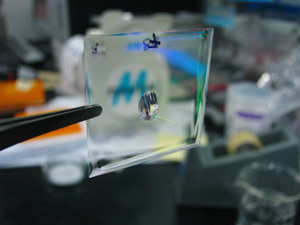Keeping in contact

A water droplet adheres to a patterned polycarbonate film even when held vertically. © 2014 A*STAR Institute of Materials Research and Engineering
A*STAR researchers have used nanoimprinting methods to make patterned polymeric films with surface topography inspired by that of a rose petal, producing a range of transparent films with high water pinning forces(1).
A surface to which a water droplet adheres, even when it is turned upside down, is described as having strong water pinning characteristics. A rose petal and a lotus leaf are both superhydrophobic, yet dissimilarities in their water pinning properties cause a water droplet to stick to a rose petal but roll off a lotus leaf.
The two leaf types differ in their micro- and nanoscale surface topography and it is these topographical details that alter the water pinning force. The rose petal has almost uniformly distributed, conical-shaped microscale protrusions with nanoscale folds on these protrusions, while the lotus leaf has randomly distributed microscale protrusions.
The imprinted surfaces developed by Jaslyn Law and colleagues at the A*STAR Institute of Materials Research and Engineering and the Singapore University of Technology and Design have uniformly distributed patterns of nanoscale protrusions that are either conical or parabolic in shape.
The researchers found that the water pinning forces on these continuously patterned surfaces were much greater than on non-patterned surfaces and surfaces composed of isolated nanopillared structures or nanoscale gratings. They could then achieve high water pinning forces by patterning the nanoprotrusions onto polymeric films with a range of different non-patterned hydrophobicities, including polycarbonate, poly(methyl methacrylate) and polydimethylsiloxane (see image).
“Other methods that recreate the water pinning effect have used actual rose petals as the mold, but unless special care is taken, there are likely to be defects and inconsistencies in the recreated pattern,” says co-author Andrew Ng. “While bottom-up approaches for making patterns — for example, laser ablation, liquid flame spray or chemical vapor deposition — are more consistent, these methods are limited in the types of patterns that can be used and the scale at which a substrate can be patterned.”
In contrast, nanoimprinting methods are capable of fabricating versatile and large-scale surfaces, and can be combined with roll-to-roll techniques, hence potentially enabling more commercial applications.
The patterned polycarbonate surfaces were also shown to reduce the ‘coffee-ring’ effect: the unevenly deposited film left behind upon the evaporation of a solute-laden droplet. This mitigation of the coffee-ring effect may assist microfluidic technologies and, more generally, the patterned surfaces could be used in arid regions for dew collection or in anti-drip applications such as in greenhouses.
The A*STAR-affiliated researchers contributing to this research are from the Institute of Materials Research and Engineering
Reference
(1) Law, J. B. K., Ng, A. M. H., He, A. Y. & Low, H. Y. Bioinspired ultrahigh water pinning nanostructures. Langmuir 30, 325–331 (2014).
Media Contact
All latest news from the category: Materials Sciences
Materials management deals with the research, development, manufacturing and processing of raw and industrial materials. Key aspects here are biological and medical issues, which play an increasingly important role in this field.
innovations-report offers in-depth articles related to the development and application of materials and the structure and properties of new materials.
Newest articles

High-energy-density aqueous battery based on halogen multi-electron transfer
Traditional non-aqueous lithium-ion batteries have a high energy density, but their safety is compromised due to the flammable organic electrolytes they utilize. Aqueous batteries use water as the solvent for…

First-ever combined heart pump and pig kidney transplant
…gives new hope to patient with terminal illness. Surgeons at NYU Langone Health performed the first-ever combined mechanical heart pump and gene-edited pig kidney transplant surgery in a 54-year-old woman…

Biophysics: Testing how well biomarkers work
LMU researchers have developed a method to determine how reliably target proteins can be labeled using super-resolution fluorescence microscopy. Modern microscopy techniques make it possible to examine the inner workings…





















